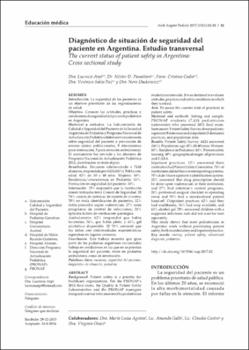| dc.description.abstract | Background. Patient safety is a priority for
healthcare organizations. For the PRONAP´s
2013 final exam, the Quality & Patient Safety
Subcommittee and the PRONAP managers
designed a survey to be answered by pediatrician
students nationwide. It was destined to evaluate
attitudes, practices and safety conditions in which
they worked.
Aim. To assess the current state of practices in
patient safety.
Material and methods. Setting and sample:
PRONAP students (7,438 pediatrician
nationwide) who answered 2013 final exam.
Instrument: Patient Safety Survey about pediatric
inpatient (9 domains) and outpatient (5 domains)
practices, and population data.
Results. Patient Safety Survey: 6424 answered
(86%). Population: age: 42% 30-40 years. Women:
80%. Residence in Pediatrics: 83%. Patient safety
training: 30%. geographical origin: all provinces
and CABA.
Inpatient practices: 15% answered their
institution had Patient Safety Committee. 74% of
institutions did not have event reporting systems,
70% didn´t have a patient´s identification system.
32% answered that drug prescription should
be done upon vademecum at their institution,
and 27% had infection´s control programs,
28% performed surgical checklist in operating
room and 55% had a standardized patient
hand-off. Outpatient practices: 62% said they
had washbasins, 56% had soap available, and
63% alcohol gel. 70% answered children with a
supposed infectious rash did not wait his turn
separately.
This study shows that most pediatricians in
Argentine work without prioritizing patient
safety, both in ambulatory and inpatient practice. | en_US |


